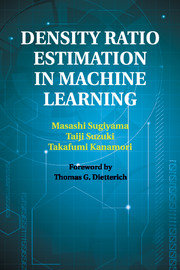Book contents
- Frontmatter
- Contents
- Foreword
- Preface
- Part I Density-Ratio Approach to Machine Learning
- Part II Methods of Density-Ratio Estimation
- Part III Applications of Density Ratios in Machine Learning
- Part IV Theoretical Analysis of Density-Ratio Estimation
- Part V Conclusions
- List of Symbols and Abbreviations
- Bibliography
- Index
Foreword
Published online by Cambridge University Press: 05 March 2012
- Frontmatter
- Contents
- Foreword
- Preface
- Part I Density-Ratio Approach to Machine Learning
- Part II Methods of Density-Ratio Estimation
- Part III Applications of Density Ratios in Machine Learning
- Part IV Theoretical Analysis of Density-Ratio Estimation
- Part V Conclusions
- List of Symbols and Abbreviations
- Bibliography
- Index
Summary
Estimating probability distributions is widely viewed as a central question in machine learning. The whole enterprise of probabilistic modeling using probabilistic graphical models is generally addressed by learning marginal and conditional probability distributions. Classification and regression – starting with Fisher's fundamental contributions – are similarly viewed as problems of estimating conditional densities.
The present book introduces an exciting alternative perspective – namely, that virtually all problems in machine learning can be formulated and solved as problems of estimating density ratios – the ratios of two probability densities. This book provides a comprehensive review of the elegant line of research undertaken by the authors and their collaborators over the last decade. It reviews existing work on density-ratio estimation and derives a variety of algorithms for directly estimating density ratios. It then shows how these novel algorithms can address not only standard machine learning problems – such as classification, regression, and feature selection – but also a variety of other important problems such as learning under a covariate shift, multi-task learning, outlier detection, sufficient dimensionality reduction, and independent component analysis.
At each point this book carefully defines the problems at hand, reviews existing work, derives novel methods, and reports on numerical experiments that validate the effectiveness and superiority of the new methods. A particularly impressive aspect of the work is that implementations of most of the methods are available for download from the authors’ web pages.
- Type
- Chapter
- Information
- Density Ratio Estimation in Machine Learning , pp. ix - xPublisher: Cambridge University PressPrint publication year: 2012



